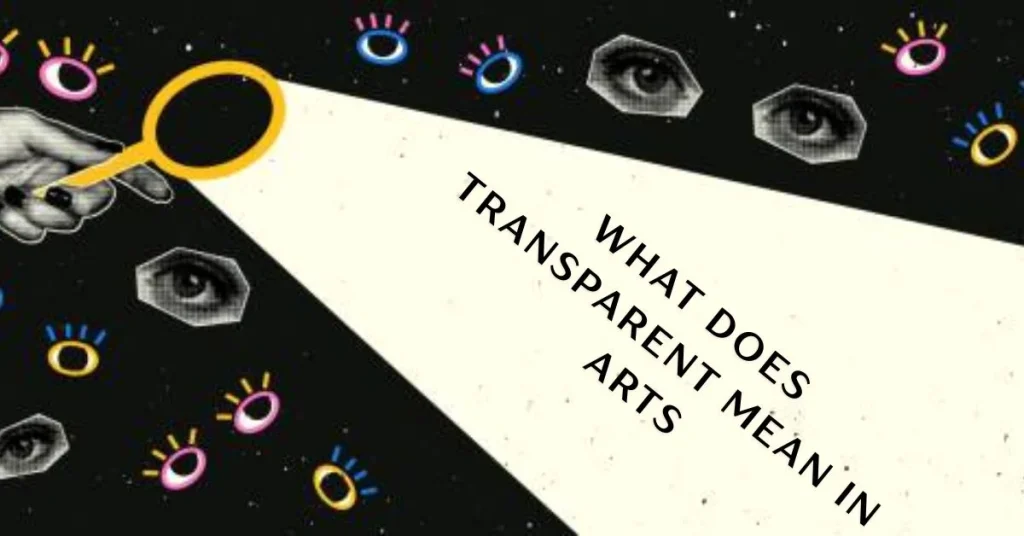When exploring the vibrant world of visual expression, you may have wondered: what does transparent mean in arts? At first glance, the term may seem straightforward — something that allows light to pass through. But in the context of art and design, transparency is far more than a physical trait. It’s a creative tool that influences perception, enhances depth, and elevates storytelling in both traditional and digital mediums.
Beyond the Surface: Defining Transparency in Art
In the simplest terms, transparency in art refers to the quality of a material or color that allows light to pass through it. Unlike opaque materials that completely block light or translucent ones that only let some light through, transparent elements allow a clear view of what’s behind them. This unique characteristic makes transparency a powerful technique for layering, color blending, and visual effects.
Artists often use transparent paints, such as certain watercolors or oil glazes, to create luminous effects that seem to glow from within. These transparent layers interact with light and underlying colors in ways that can’t be replicated with opaque paints, offering a richness and dimension that captivates the eye.
Creating Depth and Dimension Through Layering
One of the most impactful uses of transparency in art is in layering. When transparent pigments are applied in successive layers, each one contributes to a sense of visual depth. Light travels through these layers, reflects off the surface underneath — like white paper or canvas — and then returns to the viewer’s eye, carrying with it a mix of all the layers it passed through.
This technique allows artists to craft subtle color transitions and atmospheric effects. For example, using transparent blue over a yellow layer will optically mix to create green. In contrast, an opaque color would simply cover the layer beneath, eliminating the opportunity for such dynamic interaction.
Transparency also makes it easier for artists to build visual complexity without muddiness. Each transparent layer enhances, rather than hides, the ones below it — preserving clarity while adding richness.
Explore related articles to deepen your understanding before you go.
Transparent vs. Opaque: What’s the Real Difference?
Understanding what does transparent mean in arts also requires grasping the difference between transparency and opacity. While transparent paints let light through and reveal what’s beneath, opaque paints block light entirely. This makes opaque colors useful for bold, solid coverage but less effective for layering or creating glowing effects.
For instance, in watercolor painting:
- Three transparent layers allow full light penetration and bounce-back, producing a luminous, multi-hued result.
- An opaque middle layer will stop light and obscure any colors beneath it, dulling the final effect.
- Three opaque layers block all light, resulting in a flat, matte appearance with no depth or visible underlayers.
Each type of paint has its place. Transparent paints are ideal for creating luminosity and subtlety, while opaque paints offer solid coverage and visual weight. Choosing between them depends on your technique and the effect you aim to achieve.
The Emotional and Aesthetic Impact of Transparency
Transparency does more than just influence technique — it also affects how viewers emotionally respond to a piece. By revealing layers beneath the surface, transparency can evoke a sense of vulnerability, openness, or complexity It captures attention, encouraging viewers to look deeper and become more involved with the artwork.
In design, transparency is used strategically to create focus or background hierarchy. For example, a transparent overlay can push certain elements to the background, allowing more important details to pop.
This principle translates beautifully across various mediums, from watercolor and oil painting to digital illustration and graphic design. Whether it’s a gauzy veil in a digital portrait or a translucent glaze in a still life, transparency adds nuance that resonates with viewers on both a visual and emotional level.
Transparency in the Digital Age: New Possibilities
Modern digital tools have expanded the creative possibilities of transparency. In software like Photoshop or Procreate, artists can easily control the transparency (or “opacity”) of each layer. This allows for intricate blending, glowing effects, and optical illusions that are difficult to achieve with traditional materials alone.
Digital transparency also introduces new methods of storytelling. With layers that can be adjusted, faded, or revealed interactively, artists and designers have the freedom to experiment more boldly — pushing the boundaries of what transparency can mean in a visual narrative.
This ease of manipulation makes transparency a vital principle in digital art, allowing artists to simulate real-world effects with incredible precision.
Practical Tips: How to Identify and Use Transparent Paints
To get the most out of transparency in your artwork, it helps to know how to spot transparent paints:
- Check the label: Many paint brands include a symbol — an empty square usually means transparent, while a solid square indicates opacity.
- Do a black line test: Paint a black line, let it dry, then brush your color over it. If the line is still visible beneath the paint, it’s likely transparent.
- Know your pigments: Paints like Indian yellow, ultramarine blue, and alizarin crimson are typically transparent. In contrast, cadmium-based colors are usually opaque.
Also, consider your medium. Watercolors and oils are naturally transparent-friendly, while gouache and chalk tend to be opaque regardless of pigment.
Final Thoughts: Why Transparency Matters
So, what does transparent mean in arts? It’s more than just a technical term — it’s a creative choice that can transform the way an artwork looks and feels. Whether used to build subtle gradients, highlight emotional depth, or achieve glowing light effects, transparency empowers artists to work with light itself as a medium.
By mastering the art of transparency, you not only enhance the visual beauty of your work but also expand the emotional and narrative possibilities. From classic painting to modern digital design, transparency continues to shape how we see — and feel — the art before us.
Loved this post? You’ll find even more just like it on our blog!







